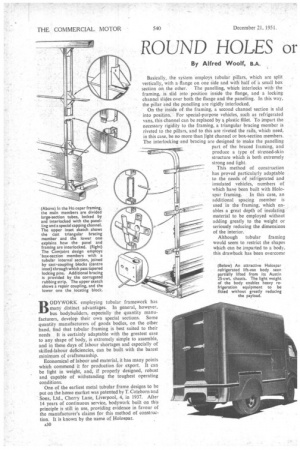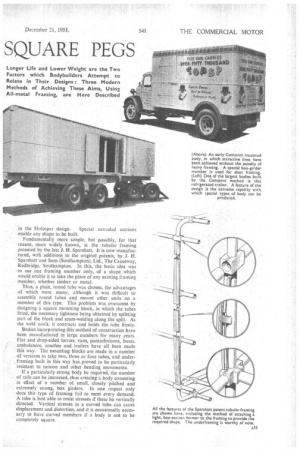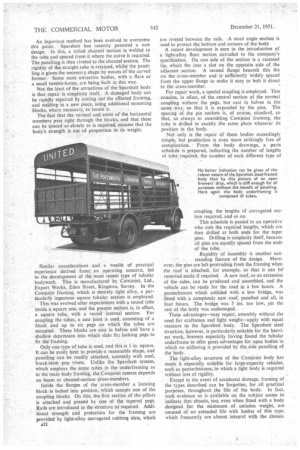ROUND HOLES or SQUARE PEGS
Page 32

Page 33

Page 34

If you've noticed an error in this article please click here to report it so we can fix it.
Longer Life and Lower Weight are the Two Factors which Bodybuilders Attempt to Relate in Their Designs : Three Modern Methods of Achieving These Aims, Using All-metal Framing, are Here Described By Alfred Woolf, B.A.
BODYWORK employing tubular framework has many distinct advantages. In general, however, bus bodybuilders, especially the quantity manufacturers, develop their own special sections. Some quantity manufacturers of goods bodies, on the other hand, find that tubular framing is best suited to their needs It is certainly adaptable with the greatest ease to any shape of body, is extremely simple to assemble, and in these days of labour shortages and especially of skilled-labour deficiencies, can be built with the barest minimum of craftsmanship.
Economical of labour and material, it has many points which commend it for production for export. It can be light in weight, and, if properly designed, robust and capable of withstanding the toughest operating conditions.
One of the earliest metal tubular frame designs to be put on the home market was patented by T. Coleborn and Sons, Ltd., Cherry Lane, Liverpool, 4, in 1937. After 14 years of continuous service, bodywork built on this principle is still in use, providing evidence in favour of the manufacturer's claims for this method of construction. It is known by the name of Holospar.
A30 Basically, the system employs tubular pillars, which are split vertically, with a flange on one side and with half of a small box section on the other. The panelling, which interlocks with the framing, is slid into position inside the flange, and a locking channel slides over both the flange and the panelling. In this way, the pillar and the panelling are rigidly interlocked.
On the inside of the framing, a second channel section is slid into position. For special-purpose vehicles, such as refrigerated vans, this channel can be replaced by a plastic fillet. To impart the necessary rigidity to the framing, a triangular bracing member is riveted to the pillars, and to this are riveted the rails, which need, in this case, be no more than light channel or box-section members. The interlocking and bracing are designed to make the panelling part of the braced framing, and produce a type of stressed-skin structure which is both extremely strong and light.
This method of construction has proved particularly adaptable to the needs of refrigerated and insulated vehicles, numbers of which have been built with Holo spar framing. In this case, an additional spacing member is used in the framing, which enables a great depth of insulating material to be employed without adding greatly to the weight or seriously reducing the dimensions of the interior.
Although tubular framing would seem to restrict the shapes which can be imparted to a body, this drawback has been overcome in the Holospar design. Special extruded sections enable any shape to be built.
Fundamentally more simple, but possibly, for that reason, more widely known, is the tubular framing patented by the fate J. H. Sparshatt. It is now manufactured, with additions to the original patents, by J. H. Sparshatt and Sons (Southampton), Ltd., The Causeway, Redbridge, Southampton. In this, the basic idea was to use one framing member only, of a shape which would enable it to take the place of any existing framing member, whether timber or metal.
• Thus, a plain, round tube was chosen, the advantages of. which were many, although it was difficult to assemble round tubes and mount other units on a member of this type. This problem was overcome by designing a square mounting block, in which the tubes fitted, the necessary tightness being obtained by splitting part of the block and seam-welding along the split. As the weld cools, it contracts and holds the tube firmly.
Bodies incorporating this method of construction have been manufactured in large numbers for many years. Flat and drop-sided lorries, vans, pantechnicons, buses, ambulances, coaches and trailers have all been made this way. The mounting blocks‘ are made in a number of versions to take two, three or four tubes, and underframing built in this way has proved to be particularly resistant to torsion and ether bending movements.
If a particularly strong body be required, the number of rails can be increased, .thus creating a body consisting in effect of a number of small, closely pitched and extremely strong, box girders. In one respect only does this type of framing fail to meet every demand. A tube is best able to resist stresses if these be vertically directed. Vertical stresses in a curved tube can cause displacement and distortion, and it is occasionally necessary to have curved members if a body is not to be completely square. An ingenious method has been evolved to overcome this point. Sparshatt has recently patented a new design. In this, a rolled channel section is welded to the tube and spaced from it where the curve is required. The panelling is then riveted to the channel section. The rigidity of the straight tube is retained, whilst the panelling is given the necessary shape by means of the curved former. Some most attractive bodies, with a flare or a small tumble-home, are being built in this way.
Not the least of the attractions of the Sparshatt body is that repair is simplicity itself. A damaged body can be rapidly repaired by cutting out the affected framing, and welding in a new piece, using additional mounting blocks, where necessary, to locate it.
The fact that the vertical and some of the horizontal members pass right through the blocks, and that these can be spaced as closely as is required, ensures that the body's strength is out of proportion to its weight.
Similar considerations and a wealth of practical experience derived from an operating concern, led to the development of the most recent type of tubular bodywork. This is manufactured by Comjoint, Ltd., Export Works, Eden Street, Kingston, Surrey. In the Comjoint framing, which is entirely light alloy, a particularly ingenious square tubular section is employed.
This was evolved after experiments with a round tube inside a square one, and the present section is, in effect, a square tube, with a round internal section. For coupling the tubes, a cast joint is used, consisting of a block and up to six pegs on which the tubes are mounted. These blocks are cast in halves and have a shallow depression into which slide the locking pegs to fix the framing.
Only one type of tube is used, and this is 1 in. square. It can be easily bent to provide a reasonable shape, and panelling can be readily attached, normally with steel, break-stem pop rivets. Unlike the Sparshatt system, which employs the same tubes in the underframing as in the main body framing, the Comjoint system depends on beam or channel-section cross-members.
Inside the flanges of the cross-member a locating block is bolted into position, which accepts one of the coupling blocks. On this, the first section of the pillars is attached and pinned by one of the tapered pegs. Rails are introduced in the structure as required. Additional strength and protection for the framing are provided by light-alloy corrugated rubbing slats, which A32 are riveted between the rails. A stout angle section is used to protect the bottom and corners of the body A recent development is seen in the introduction of a light-alloy floor section extruded to the company's specification. On one side of the section is a recessed lip, which fits into a slot on the opposite side of the adjacent section. A second flange beneath this fits on the cross-member and is sufficiently widely spaced from the upper flange to make it easy to bolt it direct to the cross-member.
For repair work, a special coupling is employed. This consists, in effect, of the central section of the normal coupling without the pegs, but cast in halves in the same way, so that it is expanded by the pins. The spacing of the pin sockets is, of course, standard, so that, as always in assembling Comjoint framing, the tube is drilled in exactly the same place wherever its position in the body.
Not only is the repair of these bodies exceedingly simple, but production is even more strikingly free of complication. From the body drawings, a parts schedule is prepared, indicating the number of lengths of tube required, the number of each different type of coupling, the lengths of corrugated section required, and so on.
This schedule is passed to an operative who cuts the required lengths, which are then drilled at both ends for the taper pins. Drilling is simplicity itself, because all pins are equally spaced from the ends of the tube.
Rapidity of assembly is another outstanding feature of the design. Moreover, the pins are left protruding from the framing when the roof is attached, for example, so that it can be' removed easily if required. A new roof, or an extension of the sides, can be produced and assembled, and the vehicle can be ready for the road in a few hours. A pantechnicon which collided with a low bridge, was fitted with a completely new roof, panelled and all, in four hours. The bridge was 5 ins, too low, yet the rest of the body was undamaged.
These advantages—easy repair, assembly without the need for craftsmen and light weight—apply with equal measure to the Sparshatt body. The Sparshatt steel structure, however, is particularly suitable for the heaviest work, brewers especially having found the tubular underframe to offer great advantages for open bodies in which no stiffening is provided by the side panelling of the body.
The light-alloy structure of the Comjoint body has made it especially suitable for large-capacity vehicles, such as pantechnicons, in which a light body is required without loss of rigidity.
Except in the event of accidental damage, framing of the types described can be forgotten, for all practical purposes, throughout the life of the body. In fact, such evidence as is ayailable on the subject seems to indicate that chasSis, too, even when fitted with a body designed for the minimum of unladen weight, are assured of an extended life with bodies of this type, which frequently are almost integral with the chassis.












































































